The PosiTector SST Soluble Salt Tester by DeFelsko is the simple, durable, and accurate way to measure salt contamination in accordance with ISO 8502-6/9–the Bresle method. This article provides an overview of the Bresle method for measuring salt contamination, a comparison of the three different patch options offered by DeFelsko, and explains how the test is performed.
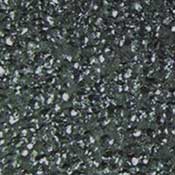
Before the application of protective coatings, steel substrates must be carefully prepared and cleaned to ensure the coating will meet performance requirements and avoid premature failure. As part of this surface preparation, abrasive blast-cleaning is commonly used to remove oxidation and existing coatings from the steel. Once the bare steel surface is exposed, there is an ever-present risk of contamination by water-soluble salts that naturally occur in an environment.
Soluble salts are not visible to the naked eye. If allowed to remain on the substrate in sufficient quantities, they can draw moisture through the coating causing premature coating failure from osmotic blistering or disbondment. In some cases, the abrasive blast media itself can be contaminated with water-soluble material (e.g., chloride or sulfate salts) which is then transferred to the steel surface during cleaning and may ultimately cause premature coating failures.
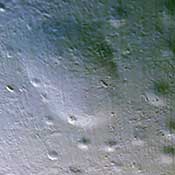
To avoid premature coating failures due to salt contamination, it is critical to ensure that the amount of soluble salts present on the blast-cleaned surface does not exceed acceptable levels. The test for water-soluble salts is done in accordance with ISO 8502-9. As a part of that method, the extraction of soluble salt contaminants for analysis is performed in accordance with ISO 8502-6—the Bresle method.

The Bresle method samples a surface by means of “surface extraction”. Put simply, this method involves placing a volume of water in a chamber against the surface. The water dissolves soluble salts present on the surface, raising the electrical conductivity of the water. The measured increase in conductivity establishes the concentration of soluble salts. Note that there is no “industry standard” for acceptable levels of surface contamination. As such, the project specification must indicate the maximum quantity of soluble salts which can remain on the surface when the coating is applied.

The PosiTector SST Soluble Salt Tester conductivity probe, when used in conjunction with either the Bresle Method PosiPatch or Bresle Method DeFelsko Patch, vastly simplifies the process of measuring soluble salt contamination. It represents a simpler and easier way to use the Bresle method. Like all DeFelsko products, each kit contains everything you need to start measuring. The PosiTector SST probe is factory calibrated and includes a Long Form Certificate of Calibration traceable to NIST.
When connected to a PosiTector Standard or Advanced gage body, the PosiTector SST conductivity probe guides users through the three simple steps required to take a conductivity measurement. It features a purpose-built test cell optimized for the range, resolution, and test volume of the Bresle method. A built-in temperature sensor compensates the reading for accuracy, and records the sample temperature during each measurement.
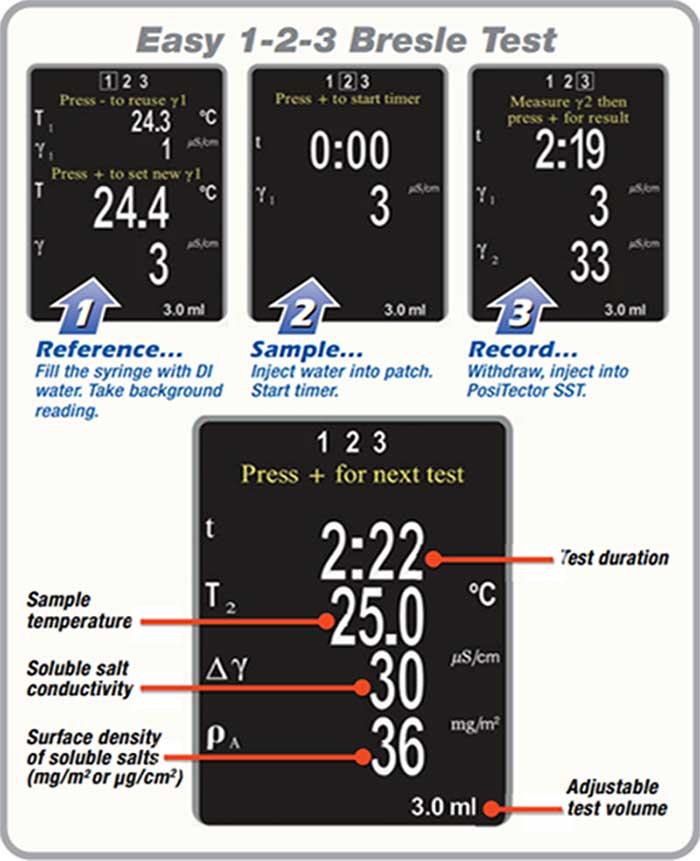
The change in conductivity and the surface density of salts is automatically calculated, displayed and saved into memory for further reporting with DeFelsko’s suite of PosiSoft Software Solutions. There is no need for math, unit conversions, or adjustments for volume and temperature. The test time is automatically measured and stored. When ‘Bresle Mode’ is deactivated, The PosiTector SST becomes a regular conductivity meter making it ideal for testing abrasive materials in accordance with ISO 11127 and ASTM D4940.
DeFelsko offers a wide variety of PosiTector SST Soluble Salt Tester Kit options:
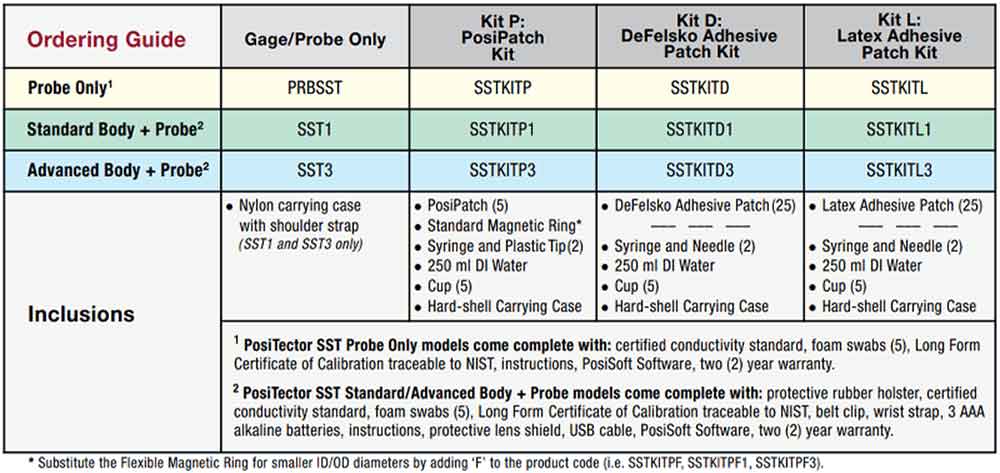
DeFelsko offers three patch options which are ideal for testing in accordance with the Bresle method.
• DeFelsko PosiPatch—Reusable Bresle test patch with Standard or Flexible magnetic ring
• DeFelsko Adhesive Patch—Self-adhesive polyurethane Bresle test patch
• Latex Adhesive Patch—Latex Bresle test patch with easy-open tabs and low-tack adhesive for easy removal

While the PosiTector SST conductivity probe can be used with any test patch that meets the requirements of the Bresle method, there are numerous advantages to the DeFelsko Adhesive Patch, and the revolutionary PosiPatch.
The DeFelsko Adhesive Patch is low cost, latex-free, and works on nearly any surface geometry. It features a low-tack adhesive, which creates a tight seal while remaining easy to remove without leaving behind any foam residue.
The revolutionary DeFelsko PosiPatch further simplifies the Bresle method. It is functionally equivalent to the Bresle Patch, but requires no adhesive, as it is held against the surface by a either a rigid or flexible magnetic holding ring. It has a built-in port which allows fluid to be injected using a dull polypropylene dispensing tip, eliminating sharp needles from the test. It features a patented air-permeable membrane, which automatically releases trapped air as water is injected, then agitates the water as it is withdrawn. It is also reusable, and a single PosiPatch can be used for multiple tests, making it the lowest per-test cost patch option available.
In our tests on freshly blasted steel with a typical 50-100 micron (2-4 mil) profile, PosiPatches were reused dozens of times with no noticeable wear or leakage. Patch life will vary depending on use—if dragged along the substrate, lifespan will be reduced.
10 uses is a very conservative estimate of lifespan and still yields the lowest per-test cost of any commercially available Bresle Method Patch. The below tables compare the per-test costs of various options, using competitive prices found online.
If performing 10 tests, and reusing the PosiPatch:

When a Latex Adhesive Patch is required, DeFelsko supplies an ISO 8502-6 conforming latex patch equipped with an easy-open tab and low-tack adhesive with TearGuard™ technology.
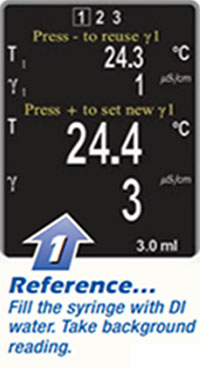
Pour at least 4 ml of deionized water into a clean cup to prevent contamination of the water source.
Fill the syringe with deionized water from the cup.
The PosiTector SST Soluble Salt Tester automatically displays the previous background measurement. Press the minus button on the PosiTector to use the previous measurement. To take a new background measurement, fill the test cell with water from the syringe and press the plus button to save the new measurement.
Draw the water back into the syringe, removing all of the solution from the test cell.
Invert the syringe, and expel the air and excess solution until there are three ml of solution remaining in the syringe.
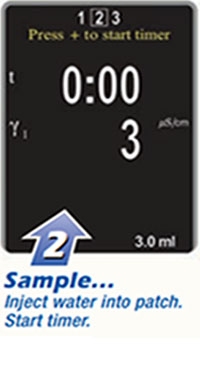
If using the PosiPatch, begin by placing it into the magnetic ring, taking care not to touch the interior.
Place the magnetic ring on the surface, and inject the water into the patch using the port. The air within the patch automatically escapes through the air-permeable membrane.
If using the DeFelsko Adhesive Patch or the Latex Adhesive Patch, remove the backing and foam center from the patch, taking care not to touch the interior. Press it firmly onto the surface making sure most of the air escapes.
Pierce the top of the patch at the foam perimeter, allowing the needle to penetrate into the center of the patch. Inject roughly half of the water into the patch. Then, withdraw the air from the patch.
Remove the syringe from the patch and expel the air. Inject the rest of the water into the patch.
Once the water is injected into either patch, press the plus button on the PosiTector SST to start the test timer. Use the syringe to repeatedly inject and withdraw the water. ISO 8502-6 recommends this process be completed at least four times and that the test time be agreed between the interested parties. Often, two minutes is sufficient.

After the desired amount of time has elapsed, use the syringe to withdraw the water from the test patch.
To complete the measurement, inject the water into the test cell of the PosiTector SST, and press the plus button.
The initial background reading is automatically subtracted from the final reading, and the test results are displayed in units of µS/cm (conductivity) and mg/m2 or µg/cm2 (surface density) along with the test time and sample temperatures—information required by most standards.

Press the plus button again to begin a new test. If memory is enabled, all results are stored for future download to one of DeFelsko’s PosiSoft Solutions, making it easy to organize measurement data and create professional, fully customizable reports. Once a reading is saved into the PosiTector memory, four free PosiSoft Solutions can manage data and create reports.
The patch can now be removed from the surface. The DeFelsko Adhesive and Latex Patch peel off the surface easier and with less residue than conventional Bresle method test patches. It is disposed of after the test.
The PosiPatch lifts cleanly off the surface, with absolutely no residue. Simply use the syringe to rinse it with DI water and reuse for several more times until worn or dirty.
The PosiTector SST Soluble Salt Tester makes the process of salt contamination measurement and reporting faster, simpler, and more accurate. The DeFelsko Adhesive Patch, Latex Patch, and innovative and reusable PosiPatch are ideal solutions for measuring salt contamination in accordance with ISO 8502-6—the Bresle method.

Click here to contact our technical sales team for more information.